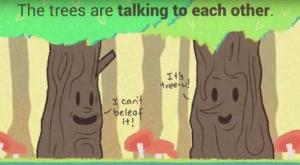According to the Bible, trees talk to each other. The prophet Isaiah prophesies about a “king of Babylon” who will throw the world into such great turmoil at the end of this age that even the trees will be so disturbed about it that they will talk to each other. I think this prophesy in Isaiah 14 is about the final Antichrist. I have a book manuscript about it that likely will be book ten in my Still Here series on Bible prophesy.
Accordingly, I believe Babylon will be rebuilt upon the ruins of the ancient city of Babylon, which are near Hallah, Iraq, to become the greatest city in the world. Thus, I interpret literally Revelation 18, which is all about this.
Isaiah predicts this king of Babylon of the end times will be a “man who made the earth tremble, who shook kingdoms, who made the world like a desert and overthrew its cities, who would not let his prisoners go home” (Isaiah 14.16-17 NRSV). The prophet further relates that he “struck down the peoples in wrath and with unceasing blows” and that he “ruled the nations in anger with unrelenting persecution” (v. 4).
Isaiah also predicts that this king of Babylon, the Antichrist, will be destroyed. But the prophet doesn’t say, here, how that will be. But he earlier did by saying, “A shoot shall come out from the stump of Jesse” (Isaiah 11.1). Jesse was the name of the father of King David of Israel, the nation’s second and greatest king. Isaiah and other writing Hebrew prophets predict that the promised Messiah will be a descendant of King David. As a Christian, I believe that messianic descendant of David was and is Jesus of Nazareth.
Isaiah continues in his prediction about this Messiah, “The spirit of the LORD shall rest on him, . . . with righteousness he shall judge the poor, and decide with equity for the meek of the earth; he shall strike the earth with the rod of his mouth and with the breath of his lips he shall kill the wicked” (Isaiah 11.2, 4). “The wicked” can be taken in two different ways: wicked people in general or a particularly wicked person. Most Bible versions follow the Masoretic Text of the Jewish Bible (Old Testament) in translating this generally as “wicked;” but the Old Greek version (Septuagint) translates it of a particularly wicked person, thus “wicked one,” who I believe refers to the final Antichrist.
Accordingly, it is Jesus the Messiah who will destroy the king of Babylon, the Antichrist, at the end of the age. For, returning to Isaiah 14, the prophet further predicts, “The LORD has broken the staff of the wicked” (Isaiah 14.5), referring to “the wicked (one)” in Isaiah 11.4.
When this happens, the trees will have quite a conversation. Isaiah tells us that at that time, “The whole earth is at rest and quiet; they break forth into singing. The cypresses exult over you,” referring to the destruction of the Antichrist, “the cedars of Lebanon, saying, ‘Since you were laid low, no one comes to cut us down” (Isaiah 14.7-8). They further discuss this at length in vv. 8-14. So, Isaiah claims the trees will be talking to each other. Is Isaiah merely being poetic, thus not being literal as we all have always thought? Or can trees really talk to each other?
(Why do the trees say of the Antichrist, “Since you were laid low, no one comes to cut us down”? During antiquity, when wars were fought the soldiers often cut down trees to make primitive armaments with which to fight wars. Most of their small weapons they brought with them, such swords, knives, clubs, bows and arrows, and spears. But if trees were available, they cut them down to construct such large armaments as siege towers, catapults, and battering rams when attacking fortresses.
But you say, “that was back then, with primitive weapons, which will not be the case in the future just as it could not be true of today.” NOT SO! I write much about this on my blog. Before the end of this age, the world will disarm itself of not only all weapons of mass destruction, such as nuclear missiles, but all advanced weapons as well. The result will be that the world will return to having only primitive weapons, such as swords, bows and arrows, spears, etc. This is made perfectly clear in several Bible prophecies about the end times, especially Ezekiel 38–39.)
Back to the question, do trees talk to each other? in 1984, David Read, a botanist at the University of Sheffield, produced a paper claiming radioactive carbons can flow through fungi between lab-grown roots of plants. In 1997, Suzanne Simard, then an ecologist with the British Columbia Ministry of Forests, produced a paper published in the prestigious ecological journal Nature that demonstrated two-way carbon transfer in a forest between young Douglas fir and paper birch trees. It was the feature article, and Nature dubbed this Read/Simard discovery as the “wood-wide web.”
Ever since, there has been much research and controversy in these fields of study about this phenomenon, in which advocates call it “trees talking.” Dr. Simard gave a 2016 TED Talk about it entitled, “How trees talk to each other.”
German forester Peter Wohlleben then wrote a book, citing Dr. Simard’s research, in which he describes the social function between trees. The book is entitled, The Hidden Life of Trees, and it has sold 3 million copies.
I won’t go into the biological complexities about how this occurs, but it sure is interesting. Maybe the prophet Isaiah wasn’t being strictly poetic, and thus nonliteral, when he predicted that trees will talk someday. If these researchers such Dr. Simard are correct, trees have always been communicating with each other.


















